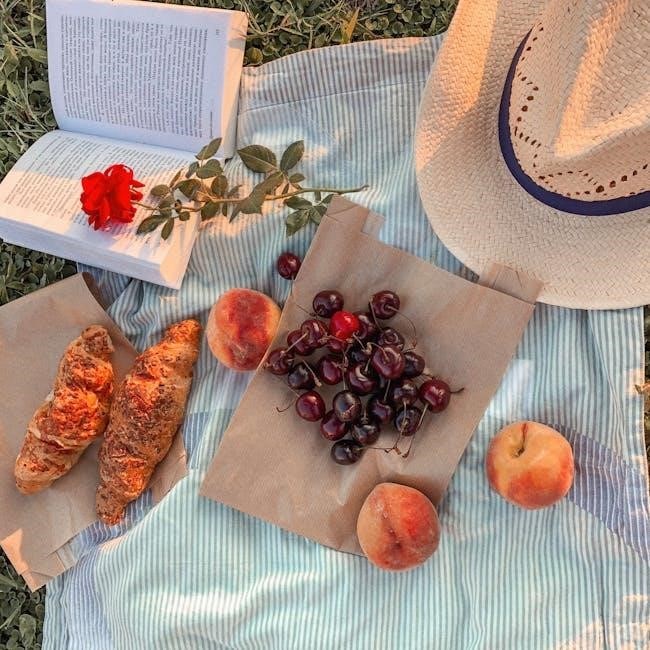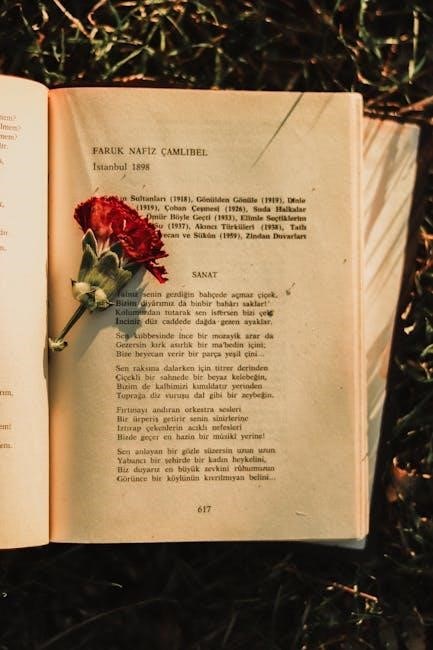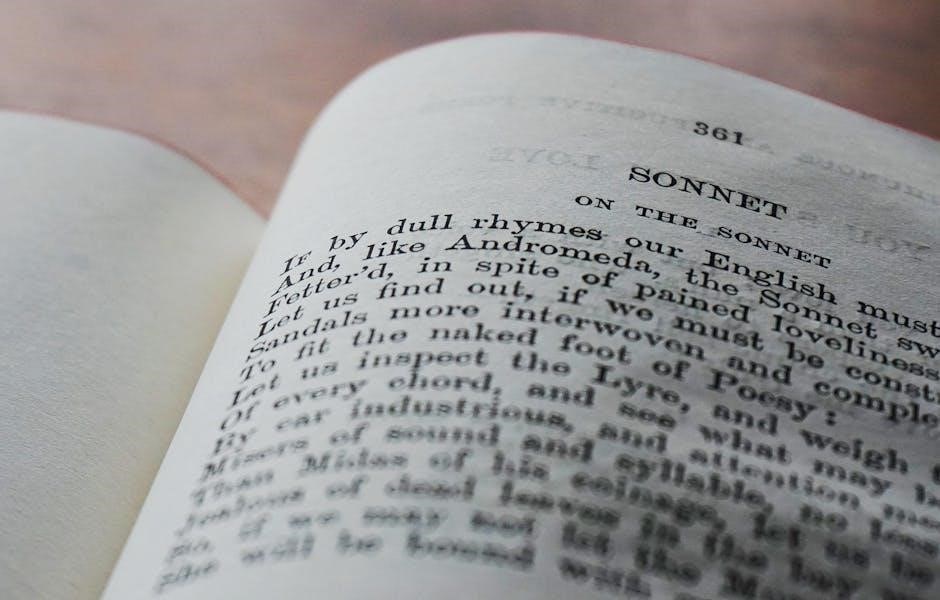Reading poetry is a journey of discovery, requiring attention to structure, rhythm, and imagery. It demands active engagement, as the reader collaborates with the poet to unlock meaning. Start by reading aloud to experience the musicality of language, then delve into themes and devices that enrich the poem’s essence.

Preparing to Read a Poem
Preparing to read a poem involves reading it multiple times and checking unfamiliar vocabulary. Observe the structure, form, and themes to build a foundation for deeper analysis and understanding of the poet’s message.
2.1. Checking New Vocabulary

Checking new vocabulary is a crucial step in preparing to read a poem. Unfamiliar words can hinder understanding, so it’s essential to identify and define them. Use a dictionary or context clues to grasp their meanings. This process helps clarify the poet’s intent and ensures a smoother reading experience. By addressing vocabulary gaps early, you can focus more on the poem’s themes and devices. Additionally, understanding specific terms enhances your ability to interpret imagery, symbolism, and tone effectively. Over time, this practice expands your literary vocabulary, making future readings more enjoyable and insightful. Don’t skip this step, as it lays the groundwork for a deeper connection with the poem’s language and message.

2.2. Observing the Structure and Form
Observing the structure and form of a poem is vital for understanding its composition and intent. Begin by noting the arrangement of lines, stanzas, and rhyme schemes, as these elements contribute to the poem’s rhythm and flow. Identify the poem’s form—whether it’s a sonnet, ballad, or free verse—which often provides clues about its themes and style. Pay attention to the length of lines and how they are grouped, as this can affect pacing and emphasis. Additionally, examine the use of meter, which creates a rhythmic pattern, and consider how it enhances the emotional impact. The structure may also reflect the poem’s subject matter, with shorter lines conveying urgency or longer lines suggesting contemplation. By analyzing these features, you gain insight into the poet’s deliberate choices and the overall aesthetic of the work. Understanding form and structure enriches your interpretation and deepens your connection to the poem’s artistic design.

Reading the Poem Aloud
Reading a poem aloud is a powerful way to connect with its rhythm, tone, and emotional resonance. This practice engages both the speaker and listener, bringing the poem to life. Start by reading slowly and deliberately, allowing the words to resonate. Pay attention to natural pauses, enjambment, and caesura, as these elements guide the flow. Emphasize rhythm and meter, which are crucial for understanding the poet’s intent. Reading aloud also helps identify patterns, such as rhyme and alliteration, that might be less noticeable on the page; Practice enunciating clearly to fully experience the musicality of language. This method not only enhances comprehension but also deepens your emotional connection to the poem. By reading aloud, you engage multiple senses, making the experience more immersive and revealing layers of meaning that silent reading might miss. This step is essential for truly appreciating the artistry and craftsmanship of poetry.

Understanding the Poem’s Content

Understanding the poem’s content involves unpacking its theme, identifying the speaker and audience, and exploring personal connections. This step reveals the poet’s message and emotional depth, enhancing your interpretation.

4.1. Identifying the Speaker and Audience
Identifying the speaker and audience is crucial for understanding the poem’s content. The speaker is the voice behind the words, which may or may not be the poet themselves. They could be a fictional character, an observer, or even an object. The audience, on the other hand, is who the speaker is addressing, whether directly or indirectly. To determine these, analyze the pronouns used (e.g., “I,” “you”) and the tone of the language. Pay attention to clues like addressing a specific group or using inclusive language. This step helps clarify the poem’s perspective and intended message. Understanding the relationship between the speaker and audience can also reveal underlying themes and emotional tones. By pinpointing these elements, you gain deeper insight into the poem’s purpose and meaning.
4.2. Unpacking the Poem’s Theme
Unpacking the poem’s theme involves identifying the central idea or message the poet conveys. Themes often relate to universal concepts like love, loss, or identity, and they emerge from the poem’s content and tone. To uncover the theme, consider the imagery, symbols, and figurative language used, as these elements often hint at deeper meanings. The speaker’s perspective and the audience’s role can also influence the theme. Pay attention to recurring motifs and how they tie together. Themes may be explicit or implicit, requiring close analysis to interpret. Sometimes, the theme is a reflection of the poet’s worldview or a commentary on societal issues. By exploring these aspects, you can grasp the poem’s underlying message and its relevance to broader human experiences. Understanding the theme enriches your connection to the poem and deepens its emotional and intellectual impact.

Analyzing Poetic Devices
Analyzing poetic devices involves identifying and interpreting techniques like imagery, symbolism, rhythm, meter, enjambment, and caesura. These elements enhance the poem’s meaning and emotional impact, revealing the poet’s craft and intent.
5.1. Paying Attention to Rhythm and Meter
Paying attention to rhythm and meter is crucial for understanding a poem’s musicality and emotional impact. Rhythm refers to the pattern of stressed and unstressed syllables, creating a sense of flow. Meter, on the other hand, is the regular repetition of rhythmic units, often measured in feet. Common meters include iambic (unstressed followed by stressed syllables) and trochaic (stressed followed by unstressed). To analyze rhythm, read the poem aloud and mark stressed syllables. Notice how the pattern contributes to the poem’s tone and pacing. Variations in rhythm, such as irregularities or pauses, can emphasize certain words or ideas. Meter helps establish structure, guiding the reader’s experience. By identifying these elements, you can uncover how the poet uses sound to enhance meaning and create a unique auditory experience, making the poem more engaging and layered in interpretation.
5.2. Looking for Enjambment and Caesura
Enjambment and caesura are essential poetic devices that shape a poem’s rhythm and meaning. Enjambment occurs when a sentence or phrase continues into the next line without punctuation, creating a seamless flow and often building momentum or connecting ideas. In contrast, caesura is a deliberate pause within a line, usually marked by punctuation, which can emphasize certain words or create dramatic effect. To identify these, read the poem aloud and note where lines run on or where natural pauses occur. Enjambment can convey urgency or excitement, while caesura might highlight emotion or reflection. These devices add layers to the poem’s structure and tone, guiding the reader’s interpretation. Paying attention to enjambment and caesura helps uncover how the poet manipulates rhythm and pacing to enhance the overall impact of the poem, making it more dynamic and engaging for the reader.
5.3. Examining Imagery and Symbolism
Imagery and symbolism are powerful tools in poetry, allowing poets to convey complex ideas and emotions through vivid descriptions and charged symbols. Imagery appeals to the senses, painting mental pictures that immerse the reader in the poem’s world. Symbolism, on the other hand, involves using objects, colors, or actions to represent abstract concepts or deeper meanings. To examine these elements, read the poem carefully and identify descriptive language that evokes sensory experiences. Look for recurring symbols and consider their cultural or personal significance. For example, a rose might symbolize love, while a raven could represent death or mystery. Pay attention to how these elements interact with other poetic devices, such as metaphor or simile, to reinforce the poem’s themes. By unpacking imagery and symbolism, you can uncover layers of meaning that enrich your understanding of the poem and its message. This step is crucial for interpreting the poet’s intent and connecting with the emotional core of the work.
5.4. Identifying Sound Devices
Sound devices are essential in poetry, enhancing the musicality and emotional impact of a poem. Common devices include rhyme, rhythm, alliteration, assonance, consonance, and onomatopoeia. Rhyme creates a harmonious effect through repeating sounds, while rhythm is established by the pattern of stressed and unstressed syllables. Alliteration and consonance involve the repetition of initial or final consonant sounds, adding texture and flow. Assonance highlights vowel sounds, creating melodic effects. Onomatopoeia imitates natural sounds, making descriptions vivid. To identify these, read the poem aloud and listen for patterns. Note how sound devices contribute to the poem’s mood, tone, and themes. For example, a lullaby might use soft rhymes and rhythms, while a dramatic poem might employ sharp consonances. Paying attention to sound devices helps uncover the poet’s craft and enriches your appreciation of the poem’s artistry and depth. This step is vital for fully engaging with the poem’s auditory and emotional layers.

Interpreting the Poem’s Meaning
Interpreting a poem’s meaning involves moving beyond the surface to uncover its deeper themes and emotions. Consider historical context, personal feelings, and the poet’s intent to fully grasp the poem’s significance and resonance.
6.1. Considering the Historical and Cultural Context
Understanding the historical and cultural context of a poem is essential for a deeper interpretation. Research the time period, societal norms, and cultural influences that shaped the poet’s work. Historical events, such as wars or revolutions, may influence themes or imagery. Cultural traditions can also affect language, symbolism, and tone. For example, a poem referencing folklore or myths may require knowledge of specific cultural narratives; Additionally, the poet’s personal background, such as their nationality, ethnicity, or social status, can provide insight into their perspective. Contextualizing the poem helps readers avoid misinterpreting references or overlooking subtle meanings. By connecting the poem to its historical and cultural roots, you can uncover layers of significance that might otherwise remain hidden. This step enriches your understanding and appreciation of the poet’s message and artistic choices.
6.2. Exploring Personal Interpretation
Personal interpretation is a vital part of understanding poetry, as it allows readers to connect with the poem on an individual level. Your unique perspective brings meaning to the text, making it a shared experience between you and the poet. Don’t be afraid to trust your instincts or question the poet’s intent. Enjoy the poem without pressure to uncover a single “correct” meaning, as poetry often invites multiple interpretations. Reflect on what resonates with you emotionally or intellectually, and consider how your experiences influence your understanding. This personal engagement fosters a deeper relationship with the poem and its themes. By embracing your interpretation, you make the poem your own, enriching the reading experience. Remember, poetry is a dialogue, and your voice matters in the conversation. This approach keeps poetry alive and relevant, as it evolves through the perspectives of each reader.
Mastering the art of reading poetry is a rewarding journey that enhances your understanding and appreciation of literature. By following the steps outlined—from preparation and analysis to interpretation—you can approach poetry with confidence. Reading aloud, identifying themes, and exploring poetic devices are essential skills that deepen your connection to the text. Remember, poetry is a shared experience, and your personal interpretation is a vital part of the process. Don’t hesitate to engage actively with the poem, as it invites you to uncover its layers of meaning. With patience and practice, you’ll find that poetry becomes a source of inspiration and insight. Embrace the journey, and let the world of poetry enrich your life with its beauty and complexity. Poetry is not just a form of art—it’s a way to see the world through new eyes, fostering empathy and understanding. Keep exploring, and let the words resonate with you.
